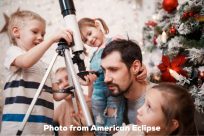 As we enter the upcoming holiday season, many folks will have likely requested stargazing kit of one sort or another as part of their gift receiving wish list. I know this to be true because binocular and telescope sales continue to be at an all-time high while memberships in amateur astronomy clubs all around the world are on the rise. Such tidings do my heart good and I am “over the moon” (sorry, couldn’t let that one go by) in knowing that more and more people have taken up the art/hobby/science of stargazing. Whether you are wanting to learn astrophotography or just the names of a few of the stars and constellations, amateur astronomy has a little something to offer a wide range of tastes and interests. The main thing is that you become active and just spend a little time outside at night looking up every now and again. Seeing as how many of us will be on break over the holidays, now is the perfect opportunity to set aside some time to do just that. For this month’s blog, I offer you three opportunities to get outside and take in the celestial sights.
As we enter the upcoming holiday season, many folks will have likely requested stargazing kit of one sort or another as part of their gift receiving wish list. I know this to be true because binocular and telescope sales continue to be at an all-time high while memberships in amateur astronomy clubs all around the world are on the rise. Such tidings do my heart good and I am “over the moon” (sorry, couldn’t let that one go by) in knowing that more and more people have taken up the art/hobby/science of stargazing. Whether you are wanting to learn astrophotography or just the names of a few of the stars and constellations, amateur astronomy has a little something to offer a wide range of tastes and interests. The main thing is that you become active and just spend a little time outside at night looking up every now and again. Seeing as how many of us will be on break over the holidays, now is the perfect opportunity to set aside some time to do just that. For this month’s blog, I offer you three opportunities to get outside and take in the celestial sights.
COMET C/2021 A1 (LEONARD)
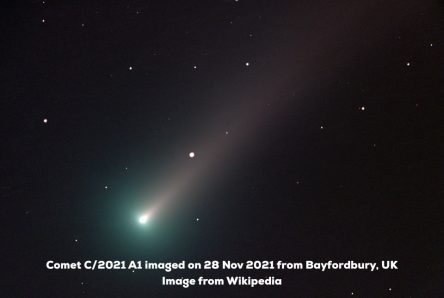 Everyone likes to see a nice, bright comet and Comet Leonard may well be as good as it gets for the year. First spotted back at the beginning of the year by astronomer Greg Leonard at the Mount Lemmon Observatory in Arizona, Comet Leonard has shown promise right from the start. Upon its discovery, there were clear indications of a tail forming, even though it was still located out near the vicinity of Jupiter (most comets don’t begin to spout a tail until they are somewhere near the orbit of Mars). It has only continued to brighten as it makes its way through the inner solar system. Right now, the comet is not visible to the unaided eye but can be seen during the morning hours with either binoculars or a small telescope under dark sky conditions. During the early days of December, look for it in the predawn skies near the bright star Arcturus.
Everyone likes to see a nice, bright comet and Comet Leonard may well be as good as it gets for the year. First spotted back at the beginning of the year by astronomer Greg Leonard at the Mount Lemmon Observatory in Arizona, Comet Leonard has shown promise right from the start. Upon its discovery, there were clear indications of a tail forming, even though it was still located out near the vicinity of Jupiter (most comets don’t begin to spout a tail until they are somewhere near the orbit of Mars). It has only continued to brighten as it makes its way through the inner solar system. Right now, the comet is not visible to the unaided eye but can be seen during the morning hours with either binoculars or a small telescope under dark sky conditions. During the early days of December, look for it in the predawn skies near the bright star Arcturus. 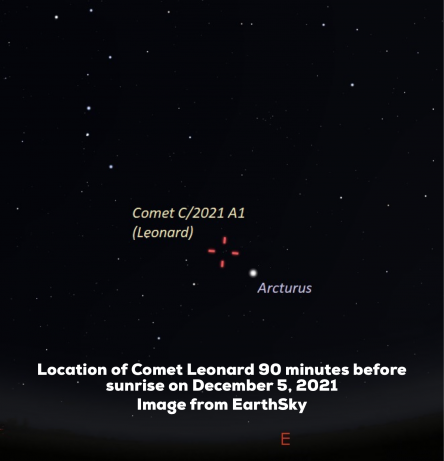 By mid-month, Comet Leonard will have transitioned to an early evening object and can be seen near Venus between December 14-16, just after sunset in the SW. The caveat here is that it will be very low in the sky and could be difficult to pick out unless you have a clear, unobstructed view down to the horizon. The good news is that its proximity to Venus will be a helpful guide in locating it. Comet Leonard is a long period comet, and its orbit takes it from the outer regions of the solar system in a shell-like reservoir of icy bodies known as the Oort Cloud, into the inner solar system every 80,000 years or so. But, before you start making plans to see it on its next pass, be aware that Leonard is now on a hyperbolic orbit, meaning that it now exceeds the escape velocity of the solar system and, once it has its close encounter with the Sun in January, it’s vaya con dios, as it exits the solar system and ventures out into interstellar space, never to return. As to how well Comet Leonard will perform, just remember, comets are notoriously unpredictable in how they behave. So, take any predictions about how bright the comet will become with a hefty dose of salt. Go to websites such as EarthSky or Sky & Telescope to get the latest news and charts that will help you locate it easier.
By mid-month, Comet Leonard will have transitioned to an early evening object and can be seen near Venus between December 14-16, just after sunset in the SW. The caveat here is that it will be very low in the sky and could be difficult to pick out unless you have a clear, unobstructed view down to the horizon. The good news is that its proximity to Venus will be a helpful guide in locating it. Comet Leonard is a long period comet, and its orbit takes it from the outer regions of the solar system in a shell-like reservoir of icy bodies known as the Oort Cloud, into the inner solar system every 80,000 years or so. But, before you start making plans to see it on its next pass, be aware that Leonard is now on a hyperbolic orbit, meaning that it now exceeds the escape velocity of the solar system and, once it has its close encounter with the Sun in January, it’s vaya con dios, as it exits the solar system and ventures out into interstellar space, never to return. As to how well Comet Leonard will perform, just remember, comets are notoriously unpredictable in how they behave. So, take any predictions about how bright the comet will become with a hefty dose of salt. Go to websites such as EarthSky or Sky & Telescope to get the latest news and charts that will help you locate it easier.
GEMINID METEOR SHOWER
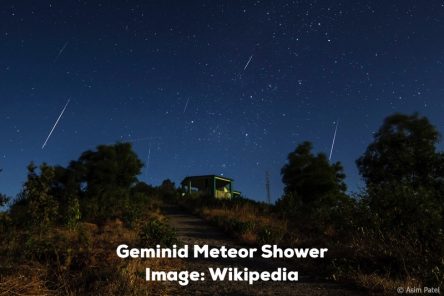 Quick: what’s the best meteor shower of the year? If you answered, “the Perseids”, then I’m sorry, that is incorrect. If you want to observe the most productive meteor shower of the year, then you need to check out December’s Geminids, not August’s Perseids. The Perseids are always listed as everyone’s favorite but that probably has more to do with the fact that the weather is nice and warm for observing, while the Geminids requires that you bundle up and drink lots of hot beverages. The Geminids are often touted as producing up to 120 to 150 meteors per hour. While this is, on average true, it assumes that you are observing under optimal conditions, something that is very rare. On top of that, on the peak night of December 13th and into the predawn hours of December 14th, the moon will be 78% full and up practically the entire night. Bummer. But, it’s not exactly a lost cause. If you seriously dial back your expectations and plan accordingly, you can still see meteors. How many? I have no idea. But if you don’t get out and look, you won’t see any at all.
Quick: what’s the best meteor shower of the year? If you answered, “the Perseids”, then I’m sorry, that is incorrect. If you want to observe the most productive meteor shower of the year, then you need to check out December’s Geminids, not August’s Perseids. The Perseids are always listed as everyone’s favorite but that probably has more to do with the fact that the weather is nice and warm for observing, while the Geminids requires that you bundle up and drink lots of hot beverages. The Geminids are often touted as producing up to 120 to 150 meteors per hour. While this is, on average true, it assumes that you are observing under optimal conditions, something that is very rare. On top of that, on the peak night of December 13th and into the predawn hours of December 14th, the moon will be 78% full and up practically the entire night. Bummer. But, it’s not exactly a lost cause. If you seriously dial back your expectations and plan accordingly, you can still see meteors. How many? I have no idea. But if you don’t get out and look, you won’t see any at all.
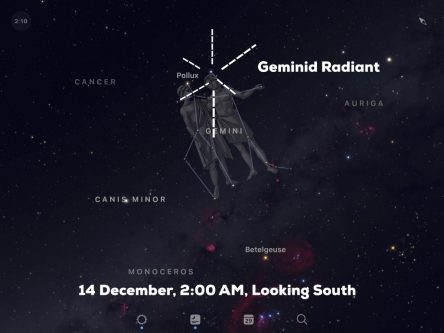 Here’s what you need to know. The Geminids are active from November 19th to around December 24th (remember, the peak is the night of the 13th and into the morning hours of the 14th), so you can see some Geminids just about any night over this time period. The parent body of the Geminids is not a comet, as is the case with most meteor showers. Instead, the parent body is an asteroid named 3200 Phaethon. The rocky rubble left in its wake creates some very bright and distinctly colored meteor streaks in our December night skies, so it is possible for a few of them to overpower some of the glare from the moon (still, the show would admittedly be better without the moon). On top of that, you can start looking for Geminids before midnight as the radiant, which is in the constellation of Gemini, is well above the horizon during the evening (the radiant is just the apparent direction on the sky from which most of the meteors seem to radiate from). Still, the best times for observing will be after midnight, say around 1:00 AM or 2:00 AM. On the peak nights, I would suggest looking during the predawn hours when the moon is either low in the sky or below the horizon. The key things to remember here are: get away from the city, bundle up, stay warm with hot beverages, get comfortable in a sleeping bag or lawn chair, and look up. Also, bring along some good friends and good tunes. Holiday memories are made when you share these kinds of things, even if you don’t see many meteors. If you want to find a good observing site, please visit the Arkansas Natural Sky website for a list of possibilities: https://darkskyarkansas.org
Here’s what you need to know. The Geminids are active from November 19th to around December 24th (remember, the peak is the night of the 13th and into the morning hours of the 14th), so you can see some Geminids just about any night over this time period. The parent body of the Geminids is not a comet, as is the case with most meteor showers. Instead, the parent body is an asteroid named 3200 Phaethon. The rocky rubble left in its wake creates some very bright and distinctly colored meteor streaks in our December night skies, so it is possible for a few of them to overpower some of the glare from the moon (still, the show would admittedly be better without the moon). On top of that, you can start looking for Geminids before midnight as the radiant, which is in the constellation of Gemini, is well above the horizon during the evening (the radiant is just the apparent direction on the sky from which most of the meteors seem to radiate from). Still, the best times for observing will be after midnight, say around 1:00 AM or 2:00 AM. On the peak nights, I would suggest looking during the predawn hours when the moon is either low in the sky or below the horizon. The key things to remember here are: get away from the city, bundle up, stay warm with hot beverages, get comfortable in a sleeping bag or lawn chair, and look up. Also, bring along some good friends and good tunes. Holiday memories are made when you share these kinds of things, even if you don’t see many meteors. If you want to find a good observing site, please visit the Arkansas Natural Sky website for a list of possibilities: https://darkskyarkansas.org
MERCURY AND VENUS CONJUNCTION
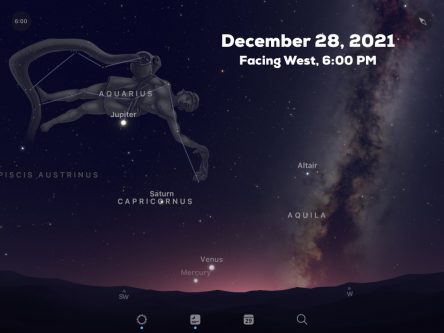 Last year, we had an impressive pairing of Jupiter and Saturn on December 21st. These kinds of line-of-sight effects are called “conjunctions” and we have another nice pairing this year with Mercury and Venus, albeit not quite as impressive as last year’s meetup with the two largest planets in our solar system. On December 28th, if the sky is clear, get out just after sunset and face the southwestern sky to see Mercury and Venus in the same binocular field of view (Mercury, the innermost planet, can be seen with the unaided eye but stands out nicely from the twilight with a little help from an inexpensive pair of binoculars). Jupiter and Saturn can be seen just above and to the left of the pair, with Jupiter shining more brightly than the more distant Saturn. Watch closely over the next 10 days as Mercury climbs higher in the sky while Venus drops lower. Venus is at its brightest this month on December 3rd but it will disappear from our evening sky on January 9, 2022. At that time, Venus will be passing in between the Earth and the Sun, something that astronomers call “inferior conjunction”. It will disappear for a while from the evening sky but will later reappear as a morning object.
Last year, we had an impressive pairing of Jupiter and Saturn on December 21st. These kinds of line-of-sight effects are called “conjunctions” and we have another nice pairing this year with Mercury and Venus, albeit not quite as impressive as last year’s meetup with the two largest planets in our solar system. On December 28th, if the sky is clear, get out just after sunset and face the southwestern sky to see Mercury and Venus in the same binocular field of view (Mercury, the innermost planet, can be seen with the unaided eye but stands out nicely from the twilight with a little help from an inexpensive pair of binoculars). Jupiter and Saturn can be seen just above and to the left of the pair, with Jupiter shining more brightly than the more distant Saturn. Watch closely over the next 10 days as Mercury climbs higher in the sky while Venus drops lower. Venus is at its brightest this month on December 3rd but it will disappear from our evening sky on January 9, 2022. At that time, Venus will be passing in between the Earth and the Sun, something that astronomers call “inferior conjunction”. It will disappear for a while from the evening sky but will later reappear as a morning object.
These are just a few of the things you can see in our December sky for 2021. I hope that the year has been kind to you and I wish you all the best during this holiday season and for the upcoming new year. May you all have clear skies for 2022!